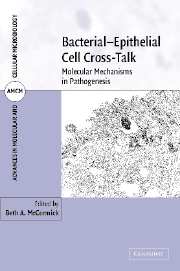Book contents
- Frontmatter
- Contents
- List of contributors
- Part I Introduction to the host and bacterial pathogens
- 1 Overview of the epithelial cell
- 2 Evolution of bacterial pathogens
- Part II Bacterial cell biology and pathogenesis
- Part III Host cell signaling by bacteria
- Part IV Exploitation of host niches by pathogenic bacteria: mechanisms and consequences
- Index
- Plate section
- References
1 - Overview of the epithelial cell
from Part I - Introduction to the host and bacterial pathogens
Published online by Cambridge University Press: 12 August 2009
- Frontmatter
- Contents
- List of contributors
- Part I Introduction to the host and bacterial pathogens
- 1 Overview of the epithelial cell
- 2 Evolution of bacterial pathogens
- Part II Bacterial cell biology and pathogenesis
- Part III Host cell signaling by bacteria
- Part IV Exploitation of host niches by pathogenic bacteria: mechanisms and consequences
- Index
- Plate section
- References
Summary
Bacteria must overcome multiple obstacles in order to achieve successful pathogenesis. In many cases, this requires bypassing the first line of host defense: the barrier provided by epithelial surfaces of the integument and the gastrointestinal, respiratory, and urinary tracts. To overcome these barriers, pathogenic organisms frequently initiate mechanisms that exploit essential cellular processes of the epithelium. These cellular processes are therefore critical to our understanding of bacterial pathogenesis. Their description is the goal of this chapter.
GASTROINTESTINAL TRACT
The gastrointestinal epithelium forms a critical interface between the internal milieu and the lumen. The latter should be considered the external environment, since the gut is essentially a tube running through the body that communicates with the external environment at each end. Thus, like the skin, the barrier formed by the gastrointestinal epithelium is critical in preventing noxious luminal contents from accessing the internal tissues. In contrast to the skin, the gastrointestinal tract must also support passive paracellular and active transcellular transport of nutrients, electrolytes, and water. The barrier formed by the gastrointestinal epithelium must therefore be highly regulated and selectively permeable. Consistent with this, barrier permeability and epithelial transport function vary at individual sites within the gastrointestinal tract according to regional differences in the specific nutrients and ions transported.
The oral cavity and esophagus are lined by stratified squamous epithelium (Figure 1.1), much like the skin.
- Type
- Chapter
- Information
- Bacterial-Epithelial Cell Cross-TalkMolecular Mechanisms in Pathogenesis, pp. 3 - 29Publisher: Cambridge University PressPrint publication year: 2006



